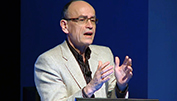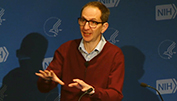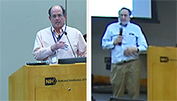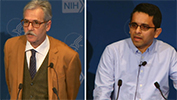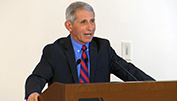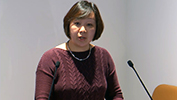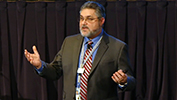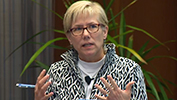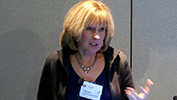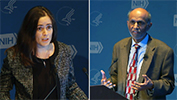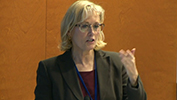-
- NIH VideoCast - National Advisory Dental and Craniofacial - January 2018
-
- - National Institute of Dental and Craniofacial Research, NIH (2018/02/02)
- - Category : Advisory Board Meetings and Workshops
- The mission of the National Institute of Dental and Craniofacial Research (NIDCR) includes the support of basic, clinical and translational research as well as the support of research training and the development of research careers. To help achieve the goals of the NIDCR, the National Advisory Dental and Craniofacial Research Council (NADCRC) has the responsibility of advising, consulting with and making recommendations to the Secretary, DHHS, and the Director, NIDCR, on matters relating to the directions of research, research support, training and career development supported by the Institute. Included in this responsibility is the conduct of the secondary review of research grant applications with a focus on NIDCR scientific program priorities and program balance as well as the conduct of research by the Division of Intramural Research, NIDCR.
NIH VideoCast - National Advisory Dental and Craniofacial - January 2018
-
- NIH VideoCast - The molecular logic of synapse formation in the brain
-
- - Thomas Christian S??dhof, M.D., 2013 Nobel Prize, Stanford School of Medicine (2018/02/02)
- - Category : WALS - Wednesday Afternoon Lectures
- NIH Director`s Wednesday Afternoon Lecture Series
Dr. Thomas C. Sudhof shared the 2013 Nobel Prize in Physiology or Medicine (with James Rothman and Randy Schekman) for "discoveries of machinery regulating vesicle traffic, a major transport system in our cells."
His current work focuses on the organization of the trans-synaptic signaling machinery that enables synapse formation and specifications as well as synaptic plasticity during development and throughout life. He and his lab members hypothesize that the number, location, and properties of synapses are determined by interactions between presynaptic and postsynaptic cell-surface recognition molecules and/or signaling molecules. They refer to the rules by which these molecules construct circuits as the molecular logic of neural circuits. Several cell-surface and signaling molecules contributing to the molecular logic of neural circuits have been characterized, most prominently presynaptic neurexin cell-adhesion molecules and their various ligands. Although neuropsychiatric disorders such as autism and schizophrenia have high incidence rates, they are poorly understood. Recent advances in sequencing technologies, however, have identified mutations in a large number of genes that predispose to autism and schizophrenia. No common theme unites the affected genes, but a subset of them encodes proteins--including notably the neurexins--that function at the synapse. Dr. Sudhof thus further hypothesizes that at least a subset of autism and schizophrenia syndromes are produced by impairments in the molecular logic of neural circuits: The input/output relations in particular circuits are shifted, but not blocked, and skew the brain`s information-processing capacity for a selected set of tasks. In support of this hypothesis, his lab observed that specific autism- and schizophrenia-associated gene mutations in neurexins and their ligands cause selective alterations in a subset of synapses and circuits that induce discrete specific behavioral abnormalities. The lab`s analysis of the molecular logic of neural circuits and their impairment in neuropsychiatric disorders has only begun. But the conceptual framework that has been outlined might allow a better understanding of how the brain processes information and of how such information processing becomes altered in autism and schizophrenia.
For his presentation, Dr. Sudhof will describe his lab`s work on testing the hypotheses inherent in this conceptual framework, focusing on families of synaptic cell-adhesion molecules such as neurexins and latrophilins. Although incomplete, the studies that he will describe have already led to surprising conclusions about how neural circuits are organized and provide a perspective for future work.
For more information go to https://oir.nih.gov/wals/2017-2018
NIH VideoCast - The molecular logic of synapse formation in the brain
-
- NIH VideoCast - Development and Function of Dendritic Cells
-
- - Boris Reizis, PhD, Professor, Department of Pathology & Medicine, NYU (2018/02/02)
- - Category : Immunology
- Immunonology IG Seminar
Dr. Reizis did his thesis research in immunology with Irun R. Cohen at the Weizmann Institute, and trained as a postdoc with Philip Leder at Harvard Medical School. In late 2003, he started his lab at Columbia University, where he became a tenured Associate Professor in 2010 and a Professor in 2014. In 2015, he joined New York University School of Medicine (NYUSoM) as a Professor in the departments of Pathology and Medicine. Boris is the director of NYUSoM Immunology and Inflammation Training programand the co-Director of the Colton Center for Autoimmunity. In 2016, he has been awarded the inaugural Dr. William E. Paul Distinguished Innovator Award from the Alliance for Lupus Research.
NIH VideoCast - Development and Function of Dendritic Cells
-
- NIH VideoCast - 2018 Demystifying Medicine: Why is HIV still a biologic and epidemiologic challenge worldwide?
-
- - John Coffin, PhD, Tufts/NCI, NIH and John Mellors, MD, University of Pittsburgh (2018/02/01)
- - Category : Demystifying Medicine
- The Demystifying Medicine Lecture Series is designed to help bridge the gap between advances in biology and their applications to major human diseases. The lectures include presentations of patients, pathology, diagnosis, and therapy in the context of major diseases and current research. All clinicians, trainees including fellows, medical students, Ph.D. students, and other healthcare and research professionals are welcome to attend.
For more information go to https://demystifyingmedicine.od.nih.gov/
NIH VideoCast - 2018 Demystifying Medicine: Why is HIV still a biologic and epidemiologic challenge worldwide?
-
- NIH VideoCast - CC Grand Rounds: 1) Precision Medicine with DNA-targeted Therapies and the Emerging Role of SLFN11 and 2) Targeting DNA Repair in Small Cell Lung Cancer
-
- - 1) Yves Pommier, MD, PhD Chief, Development Therapeutics Branch and Senior Investigator and Head, Molecular Pharmacology Group, Center for Cancer Research, NCI, NIH and 2) Anish Thomas, MBBS, MD, Investigator, NIH Lasker Clinical Research Scholar, Development Therapeutics Branch, Center for Cancer Research, NCI, NIH (2018/02/01)
- - Category : Clinical Center Grand Rounds
- CC Grand Rounds: 1) Precision Medicine with DNA-targeted Therapies and the Emerging Role of SLFN11 and 2) Targeting DNA Repair in Small Cell Lung Cancer
For more information go to http://www.cc.nih.gov/about/news/grcurrent.html
NIH VideoCast - CC Grand Rounds: 1) Precision Medicine with DNA-targeted Therapies and the Emerging Role of SLFN11 and 2) Targeting DNA Repair in Small Cell Lung Cancer
-
- NIH VideoCast - NIAID Advisory Council Meeting - January 2018
-
- - Dr. Anthony S. Fauci, Director, NIAID, NIH (2018/01/31)
- - Category : National Institute of Allergy and Infectious Diseases
- Dr. Anthony S. Fauci will address the full council. Dr. Eric Dishman will address the full council.
NIH VideoCast - NIAID Advisory Council Meeting - January 2018
-
- NIH VideoCast - The Evolution of Viral Networks: H1N1, Ebola, and Zika
-
- - Theresa MacPhail, PhD, Assistant Professor, Science and Technology Studies, Stevens Institute of Technology (2018/01/31)
- - Category : History of Medicine
- National Library of Medicine History of Medicine
Author of The Viral Network: A Pathography of the H1N1 Influenza Pandemic (Cornell University Press, 2014), Dr. MacPhail will address the culture of public health, the production of scientific knowledge, networks of expertise, information sharing, and everyday experiences of epidemiologists, microbiologists, biomedical scientists, and medical practitioners. Her lecture is the keynote address of Viral Networks: An Advanced Workshop in Digital Humanities and Medical History, which brings together scholars from various fields of medical history whose innovative research shows promise through the use of methods, tools, and data from the digital humanities.
NIH VideoCast - The Evolution of Viral Networks: H1N1, Ebola, and Zika
-
- NIH VideoCast - Basal Ganglia Circuits with the Cerebral Cortex and the Cerebellum: Networks for Movement, Cognition and Affect
-
- - Peter Strick, Ph.D., University of Pittsburgh (2018/01/31)
- - Category : Neuroscience
- NIH Neuroscience Series Seminar
Dr. Strick`s research focuses on 4 major topics: (i) the motor areas of the cerebral cortex- their involvement in movement generation and control, as well as in motor skill acquisition and retention; (ii) the motor, cognitive and affective functions of the basal ganglia and cerebellum; (iii) the neural basis for the mind-body connection; and (iv) unraveling the complex neural networks that comprise the central nervous system.
For more information go to https://neuroscience.nih.gov/neuroseries/Home.aspx
NIH VideoCast - Basal Ganglia Circuits with the Cerebral Cortex and the Cerebellum: Networks for Movement, Cognition and Affect
-
- NIH VideoCast - Division of Allergy, Immunology and Transplantation Subcommittee - January 2018
-
- - NIAID, NIH (2018/01/31)
- - Category : National Institute of Allergy and Infectious Diseases
- Report from Division Director and Division Staff
NIH VideoCast - Division of Allergy, Immunology and Transplantation Subcommittee - January 2018
-
- NIH VideoCast - Division of Microbiology and Infectious Diseases Subcommittee - January 2018
-
- - NIAID, NIH (2018/01/31)
- - Category : National Institute of Allergy and Infectious Diseases
- Report from Division Director and Division Staff
NIH VideoCast - Division of Microbiology and Infectious Diseases Subcommittee - January 2018
-
- NIH VideoCast - AIDS Research Advisory Committee - January 2018
-
- - Division of AIDS, NIAID, NIH (2018/01/31)
- - Category : AIDS Research Advisory Committee
- January 29, 2018 AIDS Research Advisory Committee Meeting
NIH VideoCast - AIDS Research Advisory Committee - January 2018
-
- NIH VideoCast - Autotherapies: Enhancing Our Innate Healing Capacity
-
- - National Institute of Dental and Craniofacial Research, NIH (2018/01/30)
- - Category : Conferences
- Autotherapies Symposium
Autotherapies are treatments based on the body???s natural ability to heal and protect itself. For example, immunotherapy harnesses the body???s immune cells to fight cancer and is now in clinical use. In the dental, oral, and craniofacial region, autotherapies could be used to selectively signal the body to repair and regenerate tissue, trigger immune responses, and restore a natural microbial balance. These strategies might also help to heal damaged or diseased tissues in other parts of the body, prevent or treat infections, fight cancer, treat autoimmune conditions, and enhance overall health.
Advancing the development of autotherapies is one of the five goals of NIDCR 2030 external link???NIDCR???s vision for the future of dental, oral, and craniofacial re
For more information go to https://www.nidcr.nih.gov/NewsAndFeatures/Announcements/2018-Autotherapies-Symposium.htm
NIH VideoCast - Autotherapies: Enhancing Our Innate Healing Capacity
-
- NIH VideoCast - NIMH Advisory Council Meeting - January 2018
-
- - NIMH, NIH (2018/01/30)
- - Category : Advisory Board Meetings and Workshops
- National Advisory Mental Health Council Open Policy Session
NIH VideoCast - NIMH Advisory Council Meeting - January 2018
-
- NIH VideoCast - BTRIS Town Hall - January 2018
-
- - Jose Galvez, MD, Clinical Center, NIH (2018/01/30)
- - Category : Special
- An introduction of the new BTRIS rollout 1.5 and website.
NIH VideoCast - BTRIS Town Hall - January 2018
-
- NIH VideoCast - NIH Council of Councils - January 2018
-
- - NIH (2018/01/30)
- - Category : Council of Councils
- The NIH Council of Councils advises the NIH Director on on the policies and activities of the Division of Program Coordination, Planning, and Strategic Initiatives (DPCPSI) in the Office of the Director, NIH. The Council also carries out concept clearance for grant programs proposed by the DPCPSI Office of Research Infrastructure Programs (ORIP) and the NIH Common Fund, and conducts second-level review of proposed ORIP grant awards, awards for the Common Fund Transformative Research Award and Early Independence Award Programs, and awards for the Environmental influences on Child Health Outcomes and All of Us Research Programs.
For more information go to https://dpcpsi.nih.gov/council/index
NIH VideoCast - NIH Council of Councils - January 2018
-
- NIH VideoCast - Adolescent Suicide Prevention Recognizing Teens at Risk & Responding Effectively
-
- - The National Institue of Mental Health, NIH (2018/01/26)
- - Category : Conferences
- Suicide is a major public health concern. Over 44,000 people die by suicide each year in the United States. Suicide is the second leading cause of death for young people aged 10-24 both in the United States and worldwide. Suicide is complicated and tragic but it is often preventable. Knowing the warning signs for suicide and how to get help can save lives. Join experts for a workshop about adolescent suicide prevention, which will include techniques for early detection and management of young people at risk.
NIH VideoCast - Adolescent Suicide Prevention Recognizing Teens at Risk & Responding Effectively
-
- NIH VideoCast - CC Grand Rounds: 1) Deep Phenotyping of a Family with Nodding Syndrome from Uganda at the Clinical Center: A Feat in Multi-Institutional Collaboration. and 2) Nodding Syndrome is an Autoimmune Encephalopathy Caused by Onchocerca Infection
-
- - 1) Ariane Soldatos, MD, MPH Director, Pediatric Neurology Consultation Service, NINDS, NIH and Physician Scientist, Undiagnosed Diseases Program, NHGRI, NIH and 2) Avindra Nath, MD Clinical Director, NINDS Senior Investigator, Section of Infections of the Nervous System, NINDS, NIH (2018/01/26)
- - Category : Clinical Center Grand Rounds
- CC Grand Rounds: 1) Deep Phenotyping of a Family with Nodding Syndrome from Uganda at the Clinical Center: A Feat in Multi-Institutional Collaboration. and 2) Nodding Syndrome is an Autoimmune Encephalopathy Caused by Onchocerca Infection
For more information go to http://www.cc.nih.gov/about/news/grcurrent.html
NIH VideoCast - CC Grand Rounds: 1) Deep Phenotyping of a Family with Nodding Syndrome from Uganda at the Clinical Center: A Feat in Multi-Institutional Collaboration. and 2) Nodding Syndrome is an Autoimmune Encephalopathy Caused by Onchocerca Infection
-
- NIH VideoCast - Preclinical cancer-target validation: How not to be wrong
-
- - William G. Kaelin Jr., M.D., Senior Physician, Brigham and Women`s Hospital; Co-Leader, Dana-Farber Cancer Institute/Harvard Cancer Center Program in Kidney Cancer; Professor, Harvard Medical School; Investigator, Howard Hughes Medical Institute (2018/01/26)
- - Category : WALS - Wednesday Afternoon Lectures
- Wednesday Afternoon Lecture Series
Published and unpublished studies by investigators in the pharmaceutical industry indicate that a disturbingly high number of academic laboratories` reports nominating potential new cancer-drug targets are either non-reproducible or, if reproducible, are not sufficiently robust to form the basis for drug-discovery efforts. The reasons are likely multifactorial, including the ubiquitous use of "down" assays in cancer biology (e.g. decreased cell proliferation, decreased tumor growth, etc.) that incorporate chemical and genetic perturbants that are prone to cause off-target effects, failure to adequately correct for multiple hypothesis testing, flawed logic when inferring causality from correlative data, and publication bias in favor of "positive" results. Improving the veracity and robustness of preclinical target-validation studies will require setting higher standards in terms of the logic, controls, and corroboration underlying their conclusions. These standards will hopefully discourage the now common practice of relegating target identification and validation experiments to the last figures of papers in an (often gratuitous) attempt to justify their "clinically relevance." Real translation happens when one has finally gathered enough knowledge to know what can be done, not by coercing basic scientists to be translational scientists.
For more information go to https://oir.nih.gov/wals/2017-2018/preclinical-cancer-target-validation-how-not-be-wrong
NIH VideoCast - Preclinical cancer-target validation: How not to be wrong
-
- NIH VideoCast - Effectors versus Protectors: How Anti-inflammatory Tissue Macrophages Maintain Tissue Homeostasis
-
- - Stefan Uderhardt, MD, NIAID, NIH (2018/01/26)
- - Category : Immunology
- Immunonology IG Seminar
Dr. Stefan Uderhardt is a post-doctoral fellow in Dr. Ronald Germain`s group within the Laboratory of Systems Biology (LSB), NIAID. Stefan received his medical degree (Dr. med.) from the University of Erlangen-N??rnberg, Germany in 2011. Early during medical school he developed a passion for immunological research, and thus spent most his spare time working on an experimental thesis on osteoimmunology in the lab of Georg Schett and Gerhard Kr??nke, investigating the mechanisms of bone loss during inflammatory arthritis. He then started a residency in rheumatology and clinical immunology at the University Hospital Erlangen, while still continuing his active bench work with research on pro- and anti-inflammatory macrophage functions in the context of clearance of apoptotic cells.
In 2014, after 3 years of hospital work, he decided to pause his clinical training and join Dr. Germain`s lab to intensify his scientific training in immunology with focus on different imaging techniques. In Dr. Germain`s lab, he developed a new intravital imaging platform, which enabled him to study different innate immune populations and their interactions under inflammatory conditions in vivo in exceptional detail. Using intravital and static multi-parameter imaging, he identified a multi-layered regulation of the initial steps in an inflammatory response to tissue damage, comprising concerted action by tissue-resident and recruited immune cells. Specifically, he found that tissue-resident macrophages, displaying an anti-inflammatory expression profile by default, actively regulate inflammatory neutrophil activation and swarming in response to tissue damage, thereby fine-tuning the threshold for onset of damaging inflammation in peripheral tissues. His work provides novel insights in mechanisms of host defense and tissue protection, and introduces potential new aspects in the treatment and management of inflammatory diseases. Stefan is a superb photographer, and his ???eye??? has led him to generate not just incredible new insights into immunobiology using microscopy methods, but to do so with images that will mesmerize while also revealing details of biology not previously visualized. His talk will be an extremely engaging combination of science and art, not to be missed.
NIH VideoCast - Effectors versus Protectors: How Anti-inflammatory Tissue Macrophages Maintain Tissue Homeostasis
-
- NIH VideoCast - National Advisory Eye Council (NAEC) - January 2018
-
- - NEI, NIH (2018/01/25)
- - Category : Advisory Board Meetings and Workshops
- Paul A. Sieving, MD, PhD, the Director of the National Eye Institute (NEI), presides as Chair and Paul A. Sheehy, Ph.D., as Executive Secretary to the National Advisory Eye Council (NAEC). The meeting is open to the public from 08:30 a.m. until 12:35 p.m. then the meeting will be closed to the public for the review of confidentiality and conflict of interest procedures and a review of grant and cooperative agreement applications on visual disorders, preservation of sight, and the special health problems and requirements of individuals with visual impairments. It also conducts the second level peer review of grant applications.
For more information go to https://nei.nih.gov/about/naec
NIH VideoCast - National Advisory Eye Council (NAEC) - January 2018




